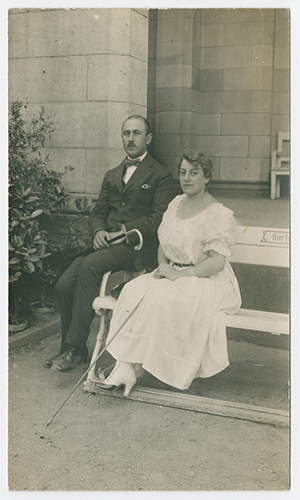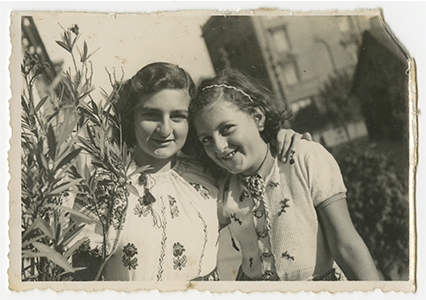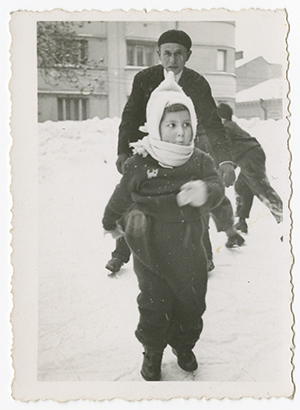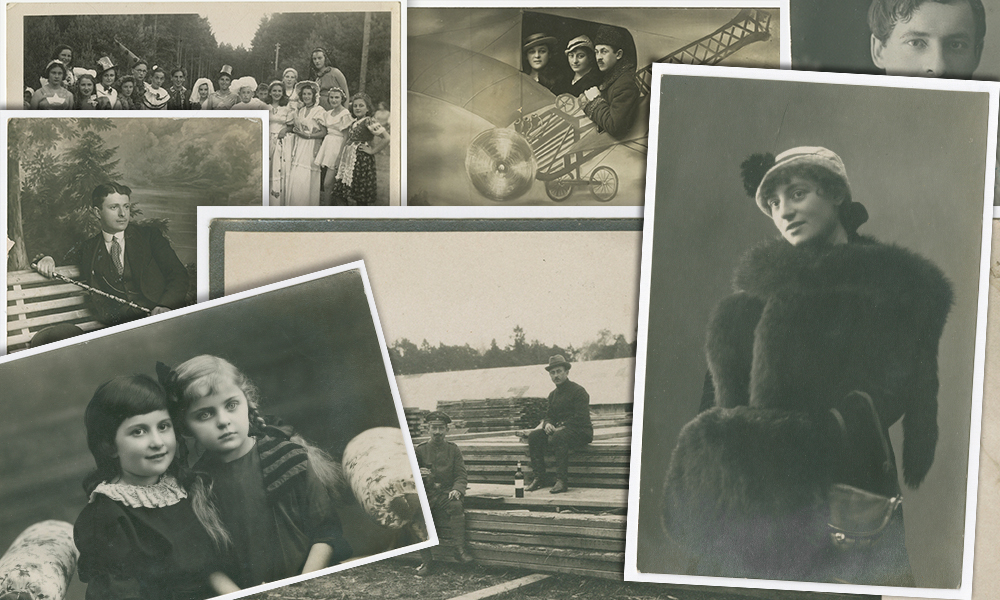Sometime during the summer or fall of 1943, a Jewish woman confined to the Kovno Ghetto in Lithuania managed at great risk to smuggle out a treasured family photo album and several personal documents. She entrusted these items to the care of a local Lithuanian woman who owned a butcher shop less than 20 yards from the ghetto fence. That woman, Terese Fedaraviciene, honored the album owner’s trust. After her death in 1969, the photographs and papers were passed on to her son Antanas and ultimately to her grandson Juozas, with whom they resided in obscurity for an additional two decades.
Seventy-five years after the album owner’s daring act, all 113 of the original photographs, along with the story behind their reemergence and the search to identify their owner and subjects, are now featured in a special exhibition at the Yeshiva University Museum in New York City. Titled “Lost & Found – A Family Photo Album,” the show is on view through April 28. The photographs, which date from the 1910s to the 1930s, were taken in Vilna (Vilnius), Kovno (Kaunas), Berlin and other urban centers where Jews and Jewish life thrived in the decades before World War II. Vilna in particular became a creative center of modern Jewish culture between the wars. These images provide rare visual evidence of the area’s once-vibrant Litvak culture and open a window on Jewish family life during this period. “In presenting these personal photographs for public viewing and consideration,” says museum director Jacob Wisse, “the exhibition fulfills the album owner’s wish to preserve these images—and the memory of the people that appear in them—for future generations.”
The unlikely clues that helped unravel the mystery and reconstruct the story of the photographs include a program for a classical music concert, an interwar telephone directory, a health resort for needy children, a Kaunas museum, a family memoir, a 1999 film and Facebook. The detectives who pieced together this disparate evidence were British photographer Richard Schofield, the founder and director of the International Centre for Litvak Photography, and Saule Valiunaite, a historian at the Vilna State Jewish Museum who specializes in the history of Jewish culture in Lithuania before World War II. Their perseverance led to the identification of the album’s owner and to the reunification of the photographs with descendants of her family.
“My heart pounds as I write you because of course this is our family.”
– Ruth R. Wisse to Richard Schofield and Saule Valiunaite, April 4, 2016
In June 1941, Lithuania, which had recently become the 14th Soviet Republic, was invaded by Nazi Germany. The Kovno Ghetto was established the following month, and the city’s more than 30,000 Jews were forced to move there. In the summer of 1943, the ghetto was taken over by the SS and turned into a concentration camp. It was at that point that the album’s owner took her bold step.
Terese Fedaraviciene’s grandson Juozas came upon the photographs and papers while clearing out his grandmother’s house in 1996. He held on to them for 17 years before bringing them to the attention of a local Kaunas politician, who in turn showed them to a fellow politician with an interest in the history of the area where the Kovno Ghetto once stood. That man organized a small exhibit of the photographs at Kaunas’s Sugihara House, a museum named for the Japanese Vice Consul in Lithuania, Chiune Sugihara, whose work issuing Jews transit visas through Japan in 1940 helped save more than 6,000 lives.
Richard Schofield, who lives in Kaunas, encountered the album’s contents while photographing an interwar telephone directory at the Sugihara House. Intrigued by the images, he was driven to find out what he could about their owner and subjects. To that end, he turned to the United States Holocaust Memorial Museum for help in digitizing the photographs. He then posted the images to Facebook under the heading “A Lost and Forgotten Family” in hopes of getting feedback about possible identifications.

Leonas and Annushka in Berlin in 1922, when she was studying at the Berlin Conservatory of Music
Historian Valiunaite took up the challenge after seeing the photographs on Facebook. “At work at the time, I was looking through many images of Lithuanian Holocaust victims and survivors, and I wanted to see if I recognized any familiar faces,” she says. “I didn’t, but I did notice a few details that made me want to look further into the photographs. I guess I just love challenges and a good mystery.” The fact that the family depicted in the photographs was socially and culturally active was extremely helpful. The program from a concert held in Vilna on February 17, 1940, for instance, was among the papers left with the album. Further sleuthing led Valiunaite to a man by the name of Leonas Varsavskis and his wife Anna (Annushka) Varsavskiene, who, along with their two daughters, had been imprisoned in the Kovno Ghetto. Another breakthrough came when she found David Roskies’ book Yiddishlands, a family memoir published in 2008, in which his aunt Annushka played a prominent role. The “cherry on top,” Valiunaite says, was discovering the 1999 family documentary Daughter of Vilna: The Life in Song of Masha Roskies, which included one of the photographs in the album. Masha Roskies, it turned out, was in fact the half-sister of Annushka—the woman that Valiunaite had now determined was the owner of the “lost and found” album.
Born Sara (or Sora) Matz in December 1896 in Vilna, Annushka Warshawska (also listed in Lithuanian as Varsavskiene), was a semi-professional singer who sometimes performed on Kovno radio. She was also the cofounder and soloist of the Engle Jewish Choir. Sara, her Jewish name, appeared on legal documents, while Annushka, described as her “Lithuanian-Yiddish” name, was used by family and friends. The Matz family was active in Jewish theater and music and owned an important publishing company of Hebrew and Yiddish books. Annushka taught music at the Kochanovsky Kindergarten in Vilna and later ran a sanatorium and camp for underprivileged and orphaned Jewish children at her summer villa in Birstonas, a small health resort south of Kaunas. Her mother, Fradl Matz, renowned as “the most beautiful woman in Vilna,” was an accomplished singer as well. Twice widowed and the mother of 12, she also ran the family publishing business after her second husband’s death.
Tragically, Annushka and her immediate family did not survive the Holocaust. Shortly after she smuggled her album out of the ghetto, she and her daughters were deported to the Klooga concentration camp in northern Estonia, where they were subsequently murdered. The fate of her husband, Leonas, who was with them in the ghetto, is unknown. Also murdered were seven of Annushka’s eleven siblings.
The only sibling to escape the Nazis was Annushka’s younger half-sister Masha Welczer Roskies. Fleeing the city of Czernowitz, which was then part of Romania, in June 1940, along with her husband, Leo, and their two children, Benjamin and Ruth, ages 9 and 4, Masha made it safely to Montreal, Canada. Among the few items she took with her were photo albums, one of which contained copies of some of the same pictures in her sister Annushka’s album.

Annushka’s daughters, Frida (left) and Bella.
Additional research led to the identities of Annushka’s surviving nieces and nephews— Ruth Roskies Wisse (a professor of Yiddish at Harvard and a well-known Yiddishist), Eva Roskies Raby, David Roskies (a professor of Yiddish literature and culture at the Jewish Theological Seminary), and their late brother Benjamin Roskies, along with their children, grandchildren and great-grandchildren. “There are no words to explain the emotions I felt when I realized that the album had living descendants,” says Valiunaite. “It felt to me that the people in the photographs would no longer remain silent and unknown, and that we’d be able to tell their story and ensure their faces and lives wouldn’t fade away in history. Also exciting for me was discovering that this is a family of prominent scholars in the field of Jewish studies and Yiddish literature.”
“We must remember that what lies behind this exhibition, says Ruth Roskies Wisse, “is the almost successful Nazi plan to eradicate the Jews of Europe. This makes our family all the more grateful for those who preserved our aunt’s album, and those who dedicated themselves to identifying its owner. In handing over this precious item, Annushka clearly intended it to reach her sister, and I genuinely believe our mother likewise expected to reconnect with her sister somehow, someday.”

Ruth Roskies Wisse, whose mother, Masha, was Annushka’s half sister, skates in Czernowitz, Romania, in the winter of 1939 or 1940. She is now a a professor of Yiddish at Harvard.
Museum director Jacob Wisse, who is Ruth Wisse’s son, co-curated the current exhibition with photographer Richard Schofield and played a key role in helping identify the individuals in many of the photographs. “It’s been remarkable and moving,” he says, “to see emerging in these photographs the same people who were so vividly brought to life through my grandmother’s stories.”
Faced with certain death in 1943, says Schofield, “Annushka Warshawska did something unique…an act that after decades of obscurity brought a lost and forgotten family back to life.”


